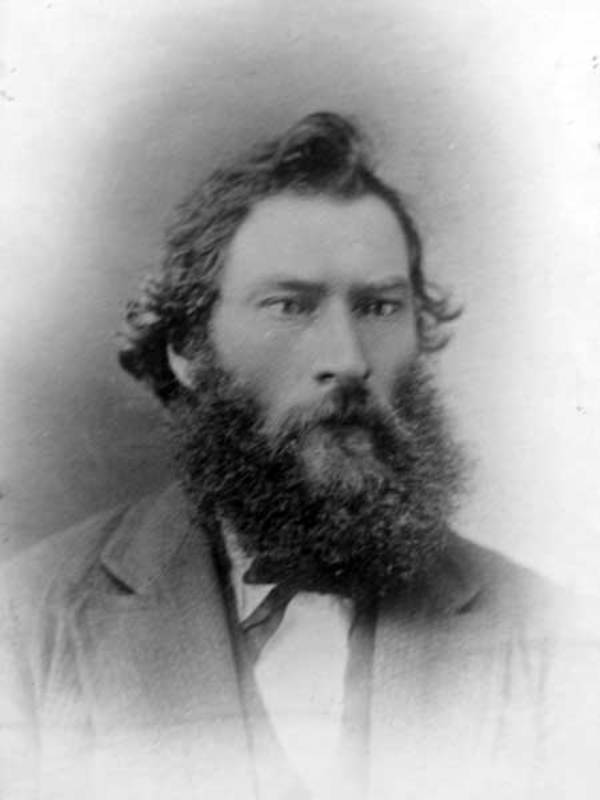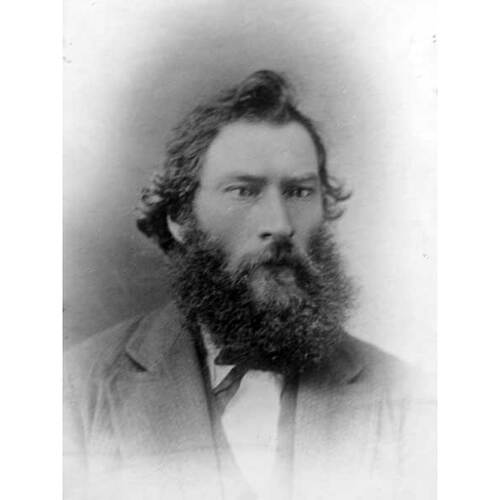
Source: Link
LÉPINE, MAXIME (Maxime-Pierre-Théodore), entrepreneur, politician, and Métis “rebel”; b. c. 1837 in St Boniface (Man.), son of Jean-Baptiste Bérard, dit Lépine, and Julia Henry; m. there c. 1857 Josephte Lavallée, and six of their children reached adulthood; d. 20 Sept. 1897 in St Louis (Sask.)
Oral tradition has it that Maxime Lépine studied for a few years with the Christian Brothers in St Boniface. He was at St François Xavier in 1870 and during the ensuing decade managed a company that transported goods by trains of Red River carts from Winnipeg as far west as the regions of Fort Canton (Sask.) and Île-à-la-Crosse and as far south as Pembina (N.Dak.) and St Paul, Minn.
Lépine was a close friend of Louis Riel* and later his “brother-in-law” by marriage. Both he and his brother Ambroise-Dydime* were members of the provisional government set up in the Red River colony in December 1869, mainly to protect the rights of the Métis in the face of Canadian annexationist moves. After Manitoba entered confederation in 1870, Maxime, unlike his brother, escaped reprisals at the hands of Ontario Orangemen. He was proud of his native background and in 1871 was a founding member of the Union Saint-Alexandre, an organization seeking to bring together Métis of French Canadian and Catholic origin. A tall man, standing 5 feet 11 inches, with an imposing countenance and piercing gray eyes, he represented St François Xavier East in the Legislative Assembly of Manitoba from 1874 to 1878.
Lépine became disenchanted with the new order in Manitoba, where the majority of newcomers were English-speaking Protestants and where the political, linguistic, and land rights of the Métis were being treated with contempt. He left the province in 1882 and moved to Saskatchewan – then the “promised land” of the Métis. Near the village of St Louis, on the South Saskatchewan, he owned a river lot, which he kept under cultivation, and also a ferry. In addition, he busied himself with various small-scale enterprises. Along with Louis Schmidt, Charles Nolin*, and Gabriel Dumont*, he worked in defence of Métis rights. The resistance movement took on new life after Riel returned from the United States in July 1884. Lépine became his right-hand man. “I have more confidence in him,” Riel declared to Father Alexis André, “than in all the priests, all the bishops, and the pope.” At Riel’s request, he and his partner Nolin turned down a substantial government contract to install telegraph poles. Lépine also served as an intermediary with the federal authorities to help Riel obtain the financial compensation he had been promised at the time of his exile.
During the 1885 uprising, Lépine was elected a councillor in the “exovedate,” a provisional government created by Riel in March. Later he moved to the camp set up at Batoche. Much against his will – “I am not keen on war,” he reportedly said – Lépine fought with two of his sons at Coulée des Tourond (Fish Creek) in April (a crucifix in one hand and a rifle in the other, according to Abbé Gabriel Cloutier) and at Batoche in May. After the defeat there he surrendered to Major-General Frederick Dobson Middleton. Following his trial at Regina in August 1885, he was sentenced to seven years in prison for high treason. He arrived at Stony Mountain Penitentiary, near Winnipeg, on 21 August but was released on 16 March 1886.
Lépine was a changed man. He felt humiliated and tried to redeem himself in the eyes of the authorities. To this end he wrote to his former bishop and benefactor, Alexandre-Antonin Taché. At the same time he maintained contact with Dumont, who was in exile in the United States. His political moves were contradictory, even opportunistic. On the one hand, he received money from Quebec Liberal leader Honoré Mercier and with Dumont and Alexandre-Pierre Fisher helped draw up and circulate a petition that the Liberals of Batoche sent to Wilfrid Laurier* in 1888; on the other hand, he joined with Nolin and local Conservatives who were also preparing a memorandum on the Métis. At a time when political patronage governed the awarding of contracts and appointments, Lépine played all his cards. He was also concerned not to displease the anti-Liberal clergy.
After 1888 Maxime Lépine withdrew from the political scene to live quietly on his farm at St Louis. In 1896, however, he supported the Liberals, and Laurier’s victory earned him a position with the Indian agency in Battleford. But a Métis “rebel” in a district with an English-speaking and “loyal” majority could not keep this position. A sad and disillusioned man, he died at St Louis in 1897.
Arch. de l’archevêché de Saint-Boniface (Saint-Boniface, Man.), Fonds Taché, 1886–92; Journal de l’abbé G. Cloutier, 5046, 5066, 5164–65, 5263; Louis Schmidt, “Mouvement des Métis à St Laurent, Saskatchewan, Territoires du Nord-Ouest en 1884,” 29793. Arch. de la Soc. hist. de Saint-Boniface, Fonds Picton, notes généal. Arch. paroissiales, St-Louis (St Louis, Sask.), Reg. des baptêmes, mariages et sépultures, 17 juin 1887, 20 sept. 1897, 18 oct. 1925. Can., Parks Canada, Prairie & Northern Region (Winnipeg), Oral hist. project, interview with Mme Béatrice Boucher (née Lépine), granddaughter of Maxime Lépine, at St Louis, 1977. Glenbow Arch., Dewdney papers, 6, corr, Gabriel Dumont to Maxime Lépine, 1887–88. NA, MG 26, G, 2: 669–96; RG 15, DII, 1, vol.335, file 83805; vol.589, file 198086. PAM, MG 14, B26, 20 Aug. 1885; RG 18, file Stony Mountain, list of prisoners, 1885. Saskatchewan Arch. Board (Saskatoon), Homestead file 4-564-908. Preliminary investigation and trial of Ambroise D. Lepine for the murder of Thomas Scott . . . , comp. G. B. Elliott and E. F. T. Brokovski (Montreal, 1874). Louis Riel, The collected writings of Louis Riel, ed. G. F. G. Stanley (5v., Edmonton, 1985), 3, 5. Weekly Herald (Calgary), 30 Sept. 1897. Walter Hildebrandt, The battle of Batoche: British small warfare and the entrenched Métis (Ottawa, 1985). Diane Payment, Batoche (1870–1910) (Saint-Boniface, 1983). George Woodcock, Gabriel Dumont: the Métis chief and his lost world (Edmonton, 1975). H. J. Daigneault, “Souvenirs,” Les Cloches de Saint-Boniface, 44 (1945): 15. R. J. A. Huel, “Louis Schmidt, patriarch of St. Louis,” Saskatchewan Hist. (Saskatoon), 40 (1987): 1–21.
Cite This Article
Diane Payment, “LÉPINE, MAXIME (Maxime-Pierre-Théodore),” in Dictionary of Canadian Biography, vol. 12, University of Toronto/Université Laval, 2003–, accessed March 29, 2025, https://www.biographi.ca/en/bio/lepine_maxime_12E.html.
The citation above shows the format for footnotes and endnotes according to the Chicago manual of style (16th edition). Information to be used in other citation formats:
| Permalink: | https://www.biographi.ca/en/bio/lepine_maxime_12E.html |
| Author of Article: | Diane Payment |
| Title of Article: | LÉPINE, MAXIME (Maxime-Pierre-Théodore) |
| Publication Name: | Dictionary of Canadian Biography, vol. 12 |
| Publisher: | University of Toronto/Université Laval |
| Year of revision: | 1990 |
| Access Date: | March 29, 2025 |



